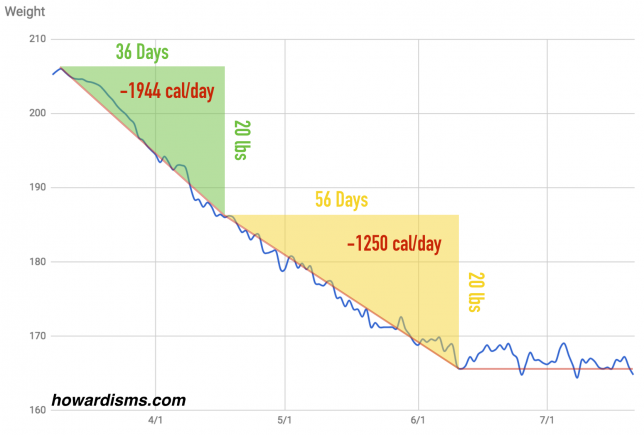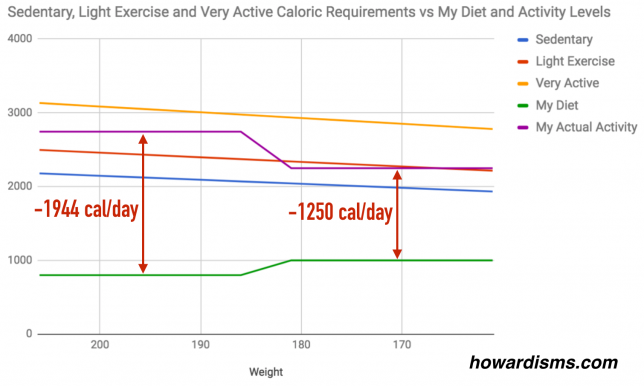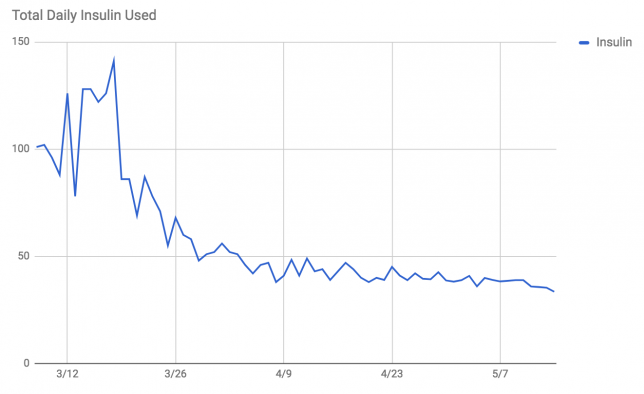When I talk to patients about weight loss, they usually tell me about their plans to exercise more and eat healthier. Recently, they ask me how I have lost 40 pounds or what magic I used to slim down. Most are sad to learn that there is no magic bullet. That being said, losing weight is rather easy and follows a set and predictable formula. In my case, as an insulin-dependent diabetic, the biggest difficulty was balancing blood sugars while losing weight. I’ll tell you what I did in a minute. But first, I would like to address those two keys I always hear people talk about: exercising and eating healthier.
Exercise definitely helps, but not in the way that one might anticipate. Exercise is helpful only in that it uses calories, but moderate exercise like walking burns few calories over the baseline metabolic rate, which means that walking adds next to nothing in terms of weight loss, particularly if a person adds a snack or a caloric exercise drink into the regimen. I have seen folks at the gym who are drinking a Gatorade or other “exercise drink” which contains more calories than the exercise they are doing consumes; these folks are actually gaining weight by going to the gym. You need real cardio to lose weight in a meaningful way: running, swimming, rowing, biking, chopping wood, etc.
“Eating healthier” is a vacuous and imprecise statement. I have talked about some of the myths related to dieting here, but suffice it to say that the only healthy thing one can do to lose weight in terms of diet is to eat less food. There are no superfoods, detoxes, metabolism-boosters, or diet plans that help a person lose weight; you just have to eat less. Understanding the caloric density of foods is important and can help you cut calories, but switching one type of food for another or restricting certain macronutrients like carbs or fats, unless it leads to fewer calories, won’t help you lose weight.
As much as people hate it, weight loss really is just about using more calories than you take in. You can do only two things: eat less and do more. Do both of these things and you’ll lose weight more quickly than if you do just one. But nothing else matters. Period. If you are honest about how many calories you take in (which can be very difficult), then your weight will follow a very predictable pattern. If you feel like you aren’t losing weight on your diet, it is simply because you are eating too much. Every obese patient I have ever met tells me that they don’t eat that much, but I can calculate how much they are eating by knowing their weight and activity levels. It may not seem like they are eating a lot to them, but they are still eating too much to lose weight.
Let’s look at what I did:
I lost 40 lbs between about March 10th and June 10th. The first 20 lbs took 36 days and the next 20 lbs took 56 days. Since then, my weight has fluctuated around 166 lbs (I started at 206), running between 164 and 169 lbs. Since one pound of fat is roughly equivalent to 3500 calories, then this means that I had to run a caloric deficit of 140,000 calories over those 92 days (about 1,000 Twinkies). As the graph above shows, I lost weight more quickly at first, averaging an almost 2000 calorie deficit each day, and then slowed down, but still averaged about a 1250 calorie deficit each day. Why the difference? Because I ate more and did less during the second 20 lbs lost than during the first. Here is a breakdown:
My caloric deficit is simply how many calories I used minus how many calories I consumed. The difference results in weight loss. Calories used is equal to the basal metabolic rate, which varies according to your current weight and gender, plus calories used with activity. As you lose weight, your caloric needs will naturally decrease (because you are smaller and are using less calories) and, therefore, you will either have to restrict even more calories to lose weight at the same pace, or just lose weight more slowly like I did. In the graph above, the blue line represents how many calories a man my size would need if he had a sedentary lifestyle; at 206 lbs, a sedentary male would require 2179 calories to maintain his weight while at 166 lbs, he would require 1961 calories (the blue line). Throw in some light exercise (20 minutes of cardio 3-4 times per week) and those numbers go up to 2497 and 2247 calories, respectively (the red line). If I were willing to do cardio every day of the week for 30 minutes, then my caloric needs would increase to 3133 and 2820 calories, respectively (the yellow line).
What I actually did at the gym is more represented by the purple line. I went intensely at first and my body was deconditioned so I used the most calories; later, I did less cardio and more weights and I was more conditioned, therefore using fewer calories. That’s the first thing we have control over: how many calories we use each day. The second part is how many we calories we consume.
I initially limited my daily caloric intake to 800 calories per day. By the second phase, I was eating closer to 1000 calories per day (the green line). The difference between the purple and the green line is my caloric deficit, and it very predictably resulted in the observed amount of weight loss.
I am sure I lost more than 40 lbs of fat, as I undoubtedly gained muscle mass. I lost 5 inches off my waste and got my 1-mile-run time down from over 13 minutes to under 8 minutes. I went from being able to do no pull-ups to being able to do more than 10. My BMI went from 31 to 25. Exercise has benefits far beyond weight loss, and truthfully, I don’t exercise enough. But as far as weight loss is concerned, it really is just a simple mathematical formula.
You can calculate your own caloric needs with this calculator. For many people who try to lose weight, the first round of dieting or calorie counting just gets them back to baseline. You don’t get obese by eating the right amount of food each day. If you are a sedentary woman who weighs 200 lbs, you can eat about 2,000 calories per day and maintain your current weight. But, the truth is, if you have decided to lose weight, it is probably because you have been gaining weight recently. If you’ve gained 20 lbs in the last 6 months, then you are not just eating 2000 calories per day. You are likely eating closer to 2500 calories per day. So when you start dieting, cutting 500 calories seems like a lot, but that was just enough to get you back to baseline. If you want to lose weight, you have to cut even more. If you wanted to lose the 20 lbs over the next 6 months, then you would have to cut 1000 calories per day from what you are currently eating (2500 minus 500 extra minus 500 to lose equals 1500 calories). Going from 2500 to 1500 calories seems drastic; but, this drastic cut will only result in losing about 3 lbs per month. This is why people quit their diets: because the drastic caloric cuts don’t seem to pay off in short term, recognizable results.
The psychology of eating so little is difficult. I believe that losing weight quickly helps, so that you can see the results and be encouraged by them. Severe calorie restriction also becomes easier with time because you become used to less food. For this reason, instead of focusing on feeling “full” by trying to eat large quantities of low calorie food, just eat less and adjust. There are no tricks, just discipline.
What is most eye-opening for people is the calorie content of the foods that they eat and how little they should be eating to lose weight. We misjudge portion sizes and misjudge calorie contents of food by a significant amount. Let’s look at some examples.
- This piece shows how easy it is to surpass 2000 calories at several fast food restaurants, including Chipotle, Taco Bell, Subway, Panera, and Starbucks. How little food it takes to get there I think will surprise you. Remember, I was eating only 800 calories all day, let alone 2000 calories for one meal!
- What might seem like the better choice is often the worst choice. The Taco Salad at Taco Bell, for example, has 960 calories. Add a regular soft drink or a side item and you can easily get to 1500 calories in one meal. You can find the calorie counts for almost every chain restaurant here.
- This table compares the calories in similar items at many different fast food restaurants. The lesson is that none of these meals are acceptable if you are dieting.
- The story is no better with sit-down restaurants. Go to Applebees and have a healthy meal: start with a Salsa Verde Beef Nachos appetizer (1/3 portion), a Green Goddess Wedge Salad, the New England Fish and Chips entree, the Triple Chocolate Meltdown for dessert, and a Blue Agavé Margarita to wash it down and you will have consumed 4500 calories in one meal (yes, that was assuming you shared the appetizer with two other people). That’s the same number of calories I would eat in 6 days while dieting.
- Home cooked meals aren’t really any better unless you have strict portion size control. In fact, most people have no idea of either how many calories are in a serving of home cooked foods or how big a serving should be. A typical plate of a home cooked dinner will have over 1000 calories. And how about seconds (and thirds)? “Portion distortion” is rampant and is the real cause for obesity in the United States. This page will teach you the basics of portion sizes and calorie counting.
Remember, I was eating only 800-1000 calories per day (not per meal). I did this by skipping breakfast (yes, it’s the right thing to do according to science) and then allowing myself about 400 calories for lunch and 400 calories for dinner. When I went to 1000 calories per day, this allowed me a couple of 100 calorie snacks each day. To do this meant a few rules:
- Never get any calories from beverages. Between water and diet sodas, there is no reason to ever add empty calories in beverages. The empty calories add up quickly. A person who drinks three 16 ounce sodas per day will consume about 580 unnecessary calories, which is more than one pound of fat per week. Here’s the calories in 12 ounces (1 can) of different drinks:
- Soda, 144 calories
- Sweet tea, 135 calories
- Orange juice, 165 calories
- Apple juice, 170 calories
- Vegetable juice, 80 calories
- Cranberry juice cocktail, 205 calories
- Whole milk, 220 calories
- Skim milk, 125 calories
- Soy milk, 180 calories
- Beer, 150 calories
- No sweets and no desserts. Prepackaged candies, snacks, and desserts are so common that we can’t help ourselves. They are also small and deceiving in terms of caloric content. Those little morsels and bites add up quickly, however, and they leave you hungry and craving more sweetness without long-lasting energy. End the vicious cycle.
- A typical piece of candy, like a Hershey’s Kiss, miniature Reese’s cup, or a Twizzler, has around 40 calories each. Eat four or five and you have 200 calories quickly.
- A bag of candy, like M&Ms, or a typical small candy bar, has between 200-300 calories.
- A piece of cheesecake, a slice of apple pie, or a slice of cake has about 410 calories.
- A cup of ice cream has about 400 calories.
- A typical cookie has about 130 calories.
- No cheating. People come up with all sorts of rationalizations for cheating on the diet, but don’t. Discipline is the key to weight loss. Cheating is a slippery slope. Exclude the things you should and you’ll crave them less and less, like candies and desserts. If you reintroduce them and treat them as a reward, you’ll continue to crave them. Find new rewards and treats; for me, tomatoes became a treat. I never knew how sweet a tomato was until it became the sweetest thing I would eat. A whole tomato only has 22 calories.
- Side dishes should almost exclusively be vegetables. With home cooked meals or buffet choices, the side dishes are all the difference. If you are going to consistently cut calories, you have to avoid carbohydrate-based side dishes and replace them with vegetables. Consider the calories per serving of the following items:
- Bad sides: fries (365 cal), mashed potatoes (214 cal), rice (206 cal), quinoa (222 cal), smallest bag of chips (160 cal), mac and cheese (310 cal), corn (162 cal), peas (118 cal).
- Good sides: broccoli (50 cal), carrots (25 cal), spinach (7 cal), okra (33 cal), cauliflower (27 cal), green beans (31 cal).
- No salad dressings or other caloric condiments. It’s the extras that ruin the value of a low calorie meal. Salad dressings and other toppers make salads some of the highest caloric meals we eat; add ketchup or melted cheese on everything and the calories start to explode. Here are calories per tablespoon of several add-ons (most people use two or three tablespoons at a minimum):
- Mayo, 94 calories
- Ranch dressing, 73 calories
- Ketchup, 19 calories
- Always pick grilled over fried. Fried foods and meats are saturated in fats and oils that taste great but add lots of calories.
- Don’t eat anything unless you know how many calories are in it. It’s just shocking how many calories are in a lot of the foods we eat everyday. When you’re honestly trying to get by on 800-1000 calories per day, you must count every one of them. So I avoided eating anything that was unknown. When people fail their diets, the mistake they almost always make is not counting calories (and portions) correctly. There’s just no wiggle room to get it wrong, and those who are obese are not very good at portion control in the first place. It must be learned. I didn’t eat at any restaurant that didn’t provide calorie amounts, and usually I found that the whole menu only had one or two choices that were less than 400 calories. I also used a lot of pre-packaged microwave dinners, which not only explicitly stated how many calories were in each, but also helped engrain a sense of portion control.
The other thing I had to do was reduce the amount of insulin I was taking, and I did so rather dramatically. I was often forced to “cheat” on my diet due to hypoglycemia, and I was surprised at how much insulin I cut out.
I went from an average of around 120 units of insulin per day to an average of around 40 units per day. Obviously, my blood sugar control improved as well with weight loss and caloric restriction.
One last point: I wasn’t that overweight or that out of shape when I decided to do this, but I was technically obese and sluggish. By lowering my weight and adding moderate exercise, I likely added about 5 years to my life expectancy, not including the positive effects on diabetes. Plus, my quality of life will be better for any remaining years. With the impact of better blood sugar control and exercise on diabetes, the true life expectancy addition may be in the 10-15 year range. Not bad for three months worth of work. Now imagine how much a more obese person has to gain!





